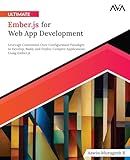Best Ember.js Unit Testing Guides to Buy in December 2025
Unit testing in Ember.js is an essential practice for ensuring the reliability and stability of your application. It involves testing individual units of code, such as components, models, and helpers, in isolation to verify their functionality. Here's an overview of how to perform unit testing in Ember.js:
- Setting up your testing environment: Install the necessary testing dependencies, such as QUnit or Mocha, which are commonly used with Ember.js. Configure the test framework according to your project's needs.
- Writing unit tests: Create a separate test file for each unit you want to test, following the naming convention with a ".test.js" suffix. Import the necessary modules, including the component, model, or helper you want to test. Define a test case using the test() function provided by your chosen testing framework. Inside the test case, write assertions using the provided assertion functions to verify the expected behavior of the unit being tested. Use setup() and teardown() functions to set up and clean up any common test scenarios.
- Testing components: Test the rendering behavior of components by rendering them with test helpers, such as render() or setupRenderingTest(), and making assertions on the resulting DOM. Interact with components by triggering events, such as clicking buttons or entering data, and asserting the expected changes in the component's state or behavior.
- Testing models: Test model behaviors, such as computed properties, relationships, or custom methods, by creating instances of the model and making assertions on their properties and methods.
- Testing helpers and utilities: Test helpers and utility functions by importing them into your test file and asserting their expected output or behavior.
- Running unit tests: Use the ember test command in the terminal to run your unit tests. Tests can be executed in the browser (via testem) or headlessly using tools like Ember CLI Mirage for mocking server responses during testing.
It's important to note that unit testing is just one piece of the testing puzzle. Ember.js also supports integration testing and acceptance testing to cover different aspects of your application's behavior. By practicing these testing methodologies, you can ensure that your Ember.js application is reliable, maintainable, and bug-free.
How to handle asynchronous operations in unit tests in Ember.js?
In Ember.js, you can use the ember-test-helpers/wait module to handle asynchronous operations in unit tests. This module provides a wait function that returns a promise, allowing you to wait for an asynchronous operation to complete before continuing with your test.
Here's an example of how you can use wait in your unit tests:
- Start by importing the necessary modules:
import { module, test } from 'qunit'; import { setupRenderingTest } from 'ember-qunit'; import { render, settled, wait } from '@ember/test-helpers';
- Set up your test module:
module('MyComponent', function(hooks) { setupRenderingTest(hooks);
test('it renders data asynchronously', async function(assert) { // ... }); });
- Write your test case:
test('it renders data asynchronously', async function(assert) { // Render your component await render(hbs``);
// Trigger an asynchronous operation, such as fetching data someAsyncOperation();
// Wait for the asynchronous operation to complete await wait();
// Assert that the expected result is rendered assert.equal(this.element.textContent.trim(), 'Expected Value'); });
In this example, the someAsyncOperation function is an asynchronous function that fetches data. By using the wait function, the test will wait until the asynchronous operation is complete before continuing with the assertions.
Additionally, you can also use the settled function to ensure that all asynchronous operations in the test have completed before continuing. This is useful when you have multiple asynchronous operations and want to assert that all of them have finished:
await settled();
By using these techniques, you can effectively handle asynchronous operations in unit tests in Ember.js.
What is the difference between unit testing and integration testing in Ember.js?
Unit testing and integration testing are two important testing methodologies in software development, including Ember.js applications. They are used to validate different aspects of the software and serve different purposes:
- Unit Testing: Unit testing focuses on testing individual units or components of an application in isolation. In the context of Ember.js, a unit can refer to a single helper, component, service, or model. Unit tests verify that each unit works as expected and functions correctly in isolation.
Key characteristics of unit testing in Ember.js:
- Tests individual units in isolation, mocking or stubbing dependencies.
- Typically written in isolation, with minimal or no interaction with other parts of the application.
- Fast and lightweight, as they don't require the entire application to run.
- Focus on testing the behavior and logic of individual units, ensuring they produce expected results.
- Integration Testing: Integration testing, on the other hand, focuses on testing the interaction and integration between different components of an application. In Ember.js, integration tests involve multiple units, such as components, services, templates, and routing, working together to validate the overall functionality of a specific feature or scenario.
Key characteristics of integration testing in Ember.js:
- Tests the interaction and integration between various components.
- Exercises multiple units as they work together, capturing real-world scenarios.
- Involves launching the Ember.js application and simulating user interactions.
- Requires more complex setup and initialization compared to unit tests.
- Ensures that components work together correctly and produce the desired outcome.
In summary, unit tests in Ember.js focus on testing individual units in isolation, while integration tests verify the interaction and integration between different components. Both testing approaches are vital for achieving comprehensive test coverage and ensuring the quality and reliability of an Ember.js application.
How to write a unit test in Ember.js?
To write a unit test in Ember.js, you can follow these steps:
- Install QUnit: Run the following command in your Ember.js application's root directory to install QUnit: npm install --save-dev qunit
- Create a test file: Create a new folder called tests in your application's root directory. Inside the tests folder, create a new file with a .test.js extension. For example, my-component.test.js.
- Import necessary dependencies: In the test file, import the necessary dependencies. For example, if you are testing a component, you may need to import the component class and Ember's test helpers. Here's an example: import { module, test } from 'qunit'; import { setupRenderingTest } from '@ember/test-helpers'; import { render } from '@ember/test-helpers'; import hbs from 'htmlbars-inline-precompile'; import Service from '@ember/service'; import { A } from '@ember/array'; import EmberObject from '@ember/object';
- Set up the test: Use the module and test functions from QUnit to define your test. Use the setupRenderingTest helper to set up a rendering test environment. Here's an example: module('Integration | Component | my-component', function(hooks) { setupRenderingTest(hooks); });
- Write the test: Inside the test function, write your test case. Use the assert object provided by QUnit to make assertions about your component's behavior. Here's an example: test('it should render a greeting', async function(assert) { assert.expect(1); await render(hbs``); assert.equal(this.element.textContent.trim(), 'Hello, Alice!'); });
- Run the test: To run the test, use the following command from your application's root directory: npx ember test --filter="" Replace with the path to your test file (relative to the tests folder). For example, if your test file is located at tests/my-component.test.js, you would use --filter="my-component".
That's it! You have written a unit test in Ember.js using QUnit.
How to run unit tests in Ember.js using Ember CLI?
To run unit tests in Ember.js using Ember CLI, you can follow these steps:
- Open your terminal and navigate to the root directory of your Ember.js project.
- Make sure you have installed Ember CLI globally. If not, you can install it by running the following command: npm install -g ember-cli
- Before running the tests, make sure your application is built and the vendor files are generated. You can do this by running the following command: ember build
- Once your application is built, you can run your unit tests by executing the following command: ember test This command will start the test runner and run all the unit tests in the /tests/unit directory.
- By default, Ember CLI uses QUnit as the testing framework, but you can also use Mocha or Jasmine. You can specify the testing framework by running the command with the --test-framework option. For example, to use Mocha, execute the following command: ember test --test-framework=mocha This command will run your tests using the Mocha testing framework.
- You can also run a specific test file by specifying the file path. For example, if you want to run only the tests in /tests/unit/controllers/my-controller-test.js, execute the following command: ember test --filter='controllers/my-controller-test' This command will run only the tests in the specified file.
That's it! You've successfully run unit tests in Ember.js using Ember CLI.
What strategies can be used for test organization and maintenance in Ember.js unit testing?
There are several strategies that can be used for test organization and maintenance in Ember.js unit testing:
- Categorize tests: Group tests by their purpose or functionality. For example, you can have separate test files for models, components, routes, etc. This helps in organizing and locating tests easily.
- Use modules: Break tests into smaller modules that focus on specific functions or features. This improves maintainability and readability of the code.
- Use descriptive test names: Give meaningful names to test functions. This makes it easier to understand the purpose of each test and quickly navigate through them.
- Utilize test helpers: Ember.js provides various test helpers that can simplify the testing process. For example, the find, click, and fillIn helpers can be used to interact with the DOM elements in tests.
- Utilize fixtures and factories: Use fixtures or factories to generate test data. This allows you to have consistent and predictable test data, making it easier to write and maintain tests.
- Use setup and teardown functions: Use the setup and teardown functions provided by Ember.js to set up and clean up test environments. This ensures that tests are independent and do not interfere with each other.
- Use test linting tools: Linting tools like ESLint can be configured to check for test-related issues, such as missing assertions or unused variables. This helps maintain code quality and reduces the chances of introducing bugs.
- Regularly review and refactor tests: Just like with production code, it's important to regularly review and refactor tests. This helps identify and remove duplicate or redundant tests, making the test suite more maintainable and faster to run.
By following these strategies, you can ensure that your Ember.js unit tests are well-organized, maintainable, and provide reliable feedback about the code's functionality.



